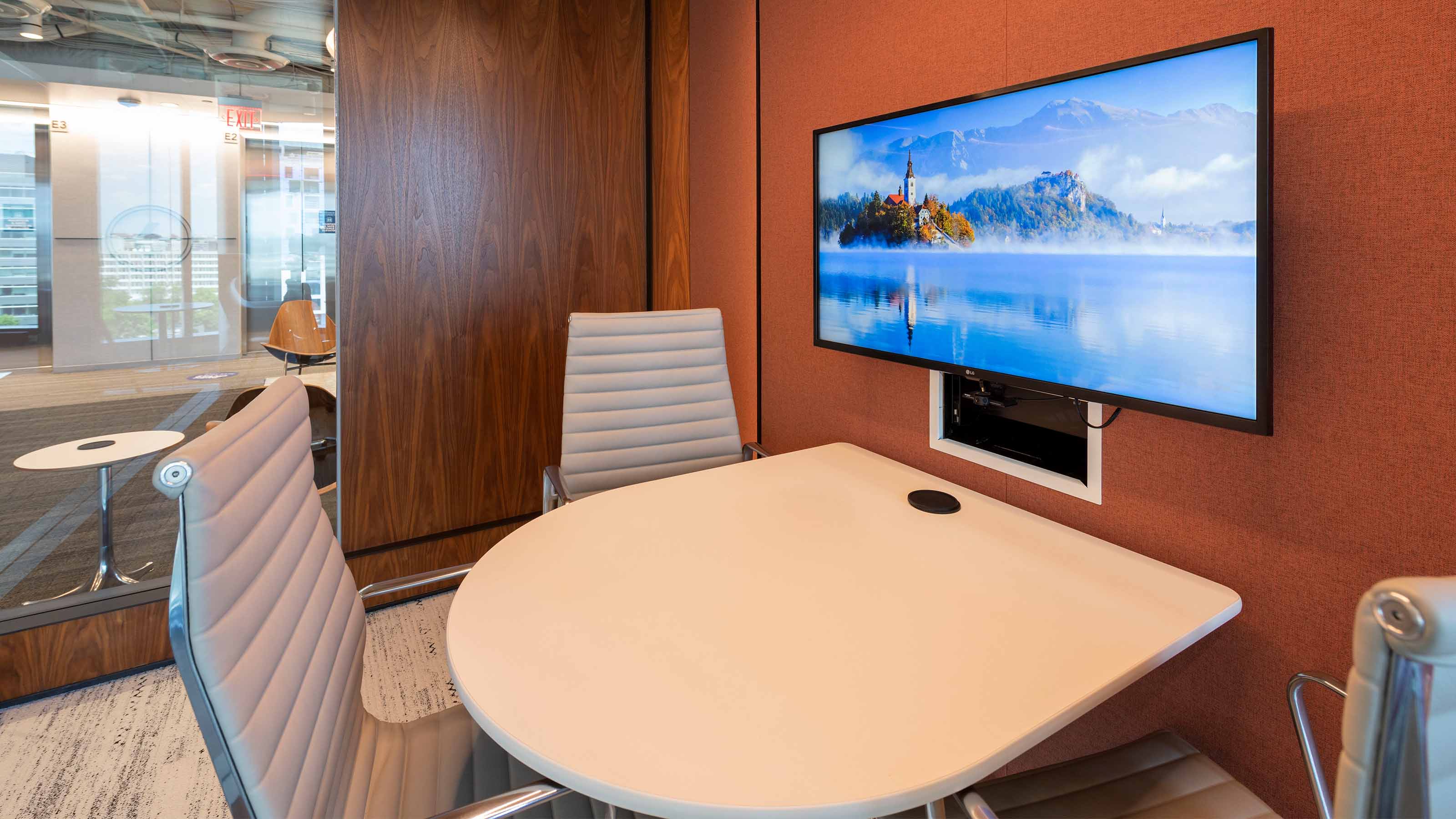With 2024, nearly upon us, SCN reached out to integrators and manufacturers across the industry to learn about the trends that will play out in 2024. Unsurprisingly, AI and hybrid were on the tips of everyone’s tongues. There are also exciting possibilities in BYOD, immersive solutions, and more. Here are some perspectives to consider as you strategize for the coming New Year.
Defining (and Deploying) Hybrid
Coming out of the pandemic, the industry was saturated with headlines about how companies were—or weren’t—developing their hybrid work strategies. Many organizations are still struggling to arrive at what their definition of hybrid is.

“We have a number of customers that were very proactive during the pandemic that began to plan forward, that invested in hybrid meeting technology, that got it into place and now are very well-prepared,” said John Bailey, senior vice president of technology and innovation at AVI-SPL, an AV/UCC integrator and digital solutions provider headquartered in Tampa, FL. However, other organizations have yet to make significant investments in this new way of working.
That said, the waiting period will soon come to an end, according to Julian Phillips, senior vice president of global workplace solutions and managing director of XTG (Experience Technology Group) at AVI-SPL. “We need to get some certainty in the market so people can reinvest and plan again,” he said.
[Blueprint for Success: Dance in the Rain]
In many cases, organizations that have rolled out hybrid work strategies have settled on requiring employees to be in the office three days a week. “If that certainty is three days a week," Phillips observed, "let’s at least get that out there so people can start moving forward.”

One of the reasons many companies are grappling with hybrid work is that it’s much less structured than the traditional work model, where employees were in the office five days a week. The asynchronous nature of hybrid work demands flexibility; even the “three-day rule” may prove too restrictive.
Ideally, a hybrid model has employees performing heads-down work remotely, and coming to the office when they need to collaborate with colleagues and clients. If they don’t really need to be in the office, it doesn’t make sense for them to be there. “The challenge with that is designing for real estate and designing the facilities to support people,” Phillips said. “If you don’t know when people are coming in, how do you build capacity and the services to support them?”

This is where organizations can leverage workplace management systems that facilitate a more dynamic work environment. In measuring occupancy levels—how many people are on site, who they are, when and where they’re present, and what activities they’re engaged in while there—companies can offer a better work experience.
AV companies can play a significant role in helping organizations with this, Phillips offered. “Why? Because we’ve been supporting people and the activities that people do—that’s our business model, effectively,” he said.
Corporate Decision Makers
Phillips noted a shift in the decision-making process for corporate AV deployments. Years ago, it was facilities departments that drove AV decision-making. As the tech moved to the network, IT took over that role. These days, he says that corporate real estate professionals are getting involved, because corporate office space must be capable of supporting hybrid work.
"Over-developed, over-designed conference rooms are going away. We’re bringing the technology to the level of how people actually use it.”
Rich Ventura, Sony Electronics
“The reality is they can no longer prove the value of a building [based on] how much it costs per square foot,” he explained. “They have to now provide that the environment creates collaboration and productivity. They have no option other than to adopt technology as a way to help support that hybrid value proposition.”
That’s not to say IT is no longer a driving force behind AV technology deployments. “IT is still going to be very much involved because of standards and security and a whole range of other things,” Phillips said. “But I do believe that we’re going to see a greater influence of people that are responsible for space and how it’s utilized.”
The need for flexibility in the built work environment should drive demand for more flexible consumption models, Bailey estimated. “We haven’t seen a lot of adoption of [as-a-Service] models, but I think we will because they lend themselves to this faster pace of acceleration and deployment,” he said. To benefit from this, AV professionals must reexamine how they execute projects. “It requires the entire industry to rethink some of these old modes we are stuck in, of complexity equals value, or we need to spend four months in planning before we can actually begin doing anything. We need to move to more simple and rapidly deployable models.”

Rich Ventura, vice president of B2B at Sony Electronics, agreed that simplicity is what clients are seeking. “Over-developed, over-designed conference rooms are going away,” he said. “We’re bringing the technology to the level of how people actually use it.”
[Sony, URI Transform Classrooms and Conference Rooms]
It’s also a good model for the integrator’s bottom line, Ventura argued. “We shouldn’t be customizing every single room we go into because that isn’t profitable,” he noted. Standardized designs are less labor intensive.
Meeting Equity Concerns
Last summer, Shure sponsored a report conducted by market research firm IDC, "The Hidden Influencer: Rethinking Audio Could Impact Your Organization Today, Tomorrow, and Forever." The research showed that 98% of respondents understand the important role hybrid meetings play in driving collaboration. How this is playing out on a practical level is producing mixed results.

“While most businesses understand that hybrid meetings remain essential for collaboration, we see clear differences in the outcomes for those that embrace and prioritize quality hybrid working models and those that seek quick-fix solutions,” said Troy Jensen, senior manager of global accounts at Shure. “Our research found that businesses with higher maturity levels are more likely to have invested in high-quality audio equipment that is standardized across the organization, resulting in an enhanced hybrid working experience for their employees.”
Video also plays a crucial role in providing an engaging hybrid meeting experience. “If there were areas [within video] that I had to point to, I would say that it’s video technology both in the cloud, in devices, and intelligent edge devices,” Bailey said.
“AI can have a big effect on not just video and audio quality, but picking up movements and specific facial expressions. I think this is one of the most creative fields where we see AI becoming very relevant.”
Max Makeev, Owl Labs
Hybrid also presents integrators with the opportunity to reexamine how they design AV for meeting spaces. “More cameras in conference rooms—let’s get away from this idea that there’s only going to be one and it’s right up there with the screen. We can have cameras all around the room, or in the middle of the room," Bailey offered. "The AI can see [an individual] from three different angles, and it can pick the best one to represent them in a hybrid call.”
As anyone who has participated remotely in a hybrid call knows, it’s difficult to achieve meeting equity when the onsite participants are in a traditional conference room. Ventura noted that 21:9 aspect ratios and features like Front Row—which unifies the backgrounds of both onsite and remote participants to make it appear as if everyone is in the same space on Microsoft Teams Rooms calls—are creating the equity that everyone is seeking. “It’s breaking down the distance between people,” he said.
[Viewpoint: A Meeting Equity Progress Report]
AI Applications
Leveraging AI-driven virtual reality, AV integrators can expedite the design process and remove some of the costs associated with the back-and-forth that traditionally occurs when developing systems. At AVI-SPL, design teams utilize AI-driven VR to help clients visualize what their environments will look and sound like in real life. Phillips said that when a firm can invite clients to sit in the virtual environment and raise any concerns, it enables AV designers to make adjustments quickly, accelerating the design process significantly.

AI also has the potential to facilitate equipment specification in common scenarios, said David Danto, director of emerging technologies at the Interactive Multimedia & Collaborative Communications Alliance (IMCCA), headquartered in Syosset, NY. For example, if a designer is using AutoCAD and pinpoints where meeting participants will be situated in a room, theoretically, well-programmed AI should be able to determine the best microphones and speakers for the application, as well as their positioning. The same could apply to lighting.

While Danto concedes that design requires both the skill and art of trained AV professionals, AI has the potential to help designers make better use of their time. “I’d love to see AI pick the displays, the locations, and the sizes based on rules we all know, and then pass it over to a senior engineer to edit and make sure the finishing touches are there,” he said. “The same thing for room setups: Have the professional go in at the end and make sure it’s tuned and signed off on and everything views correctly.”
Ken Kobayashi, business manager at Sony, noted that the AI that drives features like auto-tracking in its PTZ cameras removes the need for operators in certain applications. “It requires less human interaction and provides more outcome,” he said. He added that these tools also allow people to be more focused on meetings and collaboration without the distraction of operating equipment as well.

The application of AI in gaming and AR/VR offers some exciting possibilities, according to Max Makeev, chief development officer and co-founder of Owl Labs. “AI can have a big effect on not just video and audio quality, but picking up movements and specific facial expressions,” he said. “I think this is one of the most creative fields where we see AI becoming very relevant.”
AI can also assist AV integrators in streamlining their back-office functions. Phillips noted that supply chain is one area where this technology can reap significant benefits. In particular, AI may be able to remodel the supply chain so AV integrators remain resilient the next time a disruption occurs.
“One of the biggest challenges we have is supply chain, not only [because of] the massive disruption during the pandemic, but we’ve had to rethink supply chain as a direct result of that,” he said. “AI tools are now starting to be used to help us to accelerate the change of the way we think about what has been a very traditional, dysfunctional, and very complicated—and costly—distribution and supply chain process.”
BYOD and Beyond

Products that perform multiple tasks in one unit are popular among end users because they reduce potential points of failure. Integrators benefit from these solutions as well, since they’re sourcing fewer SKUs, argued Mark Bonifacio, director of business management at Sony.
He pointed to Sony’s SRG Series of PTZ cameras, with auto-tracking features that don't require subjects to wear additional hardware for the camera to follow them. “We’re using AI and doing multiple points of detection of the [subject] to identify who it’s supposed to track and follow them,” Bonifacio explained. “This has enabled us to track very smoothly and also frame and zoom to the person’s face.”

Years ago, many IT managers discouraged people from using their own devices at work because of the associated security risks. In the hybrid work model, though, BYOD is largely unavoidable.
Eric Farkas, senior product engineer at Black Box, noted that the company’s MediaCento and 10G MCX AVoIP solutions offer flexibility in the hybrid BYOD environment. “They [deliver] connectivity options that allow for BYOD AV inputs and multiple USB connections for webcams, speakers, and microphones while utilizing Ethernet connectivity that allows hardware to be unobtrusively located where it’s needed,” he said. These solutions are expandable and can be networked to extend outside of the conference room to power digital signage systems and video walls.

Joe da Silva, vice president of marketing at Extron, noted that conferencing participants are demanding user-friendly connectivity, and Extron’s UCS 303 three-input presentation switcher is a potential tool for achieving this. “Our customers want to not only use their laptops to connect with a meeting room’s display and UC systems to share content with local and remote users, but also connect with the room’s resources, such as cameras and microphones, for an improved collaborative presentation experience,” he said.
The hybrid work model also requires organizations to communicate to their employees more than they ever have. To engage people, video communications must boast a high production value. Developing this messaging can become cost-prohibitive if each communications campaign must be outsourced to an agency. This has led an increasing number of companies to deploy their own in-house facilities, including production studios and VR stages.
“They’re investing in architecture to produce, stream, and distribute [these communications] across their organizations,” Phillips said. “They’re almost becoming their own mini-broadcasters.”
Immersive Invades Corporate

Immersive environments in corporate offices can help to draw employees back into the office and keep them there, according to Tom Bingham, senior manager of vertical sales at LG. “Thoughtfully designed immersive environments have an impact on employee morale—being in a modern, technologically advanced space reflects well on employers, cultivating a sense of pride in employees,” he said.
Bingham added that these facilities are also cross-functional, producing a high ROI. “A high-quality immersive environment with dvLED and OLED displays can not only be used for digital signage and hybrid conferencing," he offered, "but can be transformed into a production space as well.”

There is also an aesthetic argument for deploying an immersive environment to draw visitors or alter how a space looks and feels. “This is true of lobbies as well as corporate boardrooms, meeting rooms, and lounges for customers and employees,” said Tom Petershack, director of media and special projects at Planar. “With today’s LED technology supporting more creative applications, customers can cover nearly any surface, including columns, curves, floors, ceilings, and more.” He added that organizations are starting to take this outdoors as well, positioning 3D forced perspective screens on buildings.
But can immersive technologies be deployed affordably in corporate facilities? According to Petershack, it’s possible.
“Today, LED display technology offers more affordable options, and while pixel pitches grow finer, it’s important to realize that many immersive, 3D environments can be achieved with coarser pixel pitches, which can help cut down on cost even more,” he said. "When experiences are designed to be viewed at a distance, a finer pixel pitch may not be necessary."
Immersive Audio
Aside from conference rooms built specifically for immersive audio, most of the audio experiences in meeting spaces is either in mono or stereo. Dr. Paul Henderson, vice president of software and immersive at Fulcrum Acoustic, encourages the industry to promote the application of immersive audio conferencing for a better experience. (Fulcrum Immersive, operating under Fulcrum Acoustic, develops a number of immersive audio solutions.)

"We’re designed to exist in a spatialized environment,” Henderson said. “Outside of the stereo world, we’re listening to cues and things that are happening all over." These include such sounds as the air conditioner that’s running in the background or the clicks of a hard drive.
“You’re used to separating information because of its spatial content," he continued. "The more we can do that in the virtual world and the immersive world, the easier it is to bridge those two together. You start to forget that you’re in the virtual world because the environment starts to fuse with the real world.”
Henderson believes binaural audio or personal audio blended with immersive technology is going to become more prevalent, even for one-on-one video calls, pointing to consumer headphones as an example. “I think we’re going to start to see a lot more spatial audio subtly put into these technologies,” he added.
